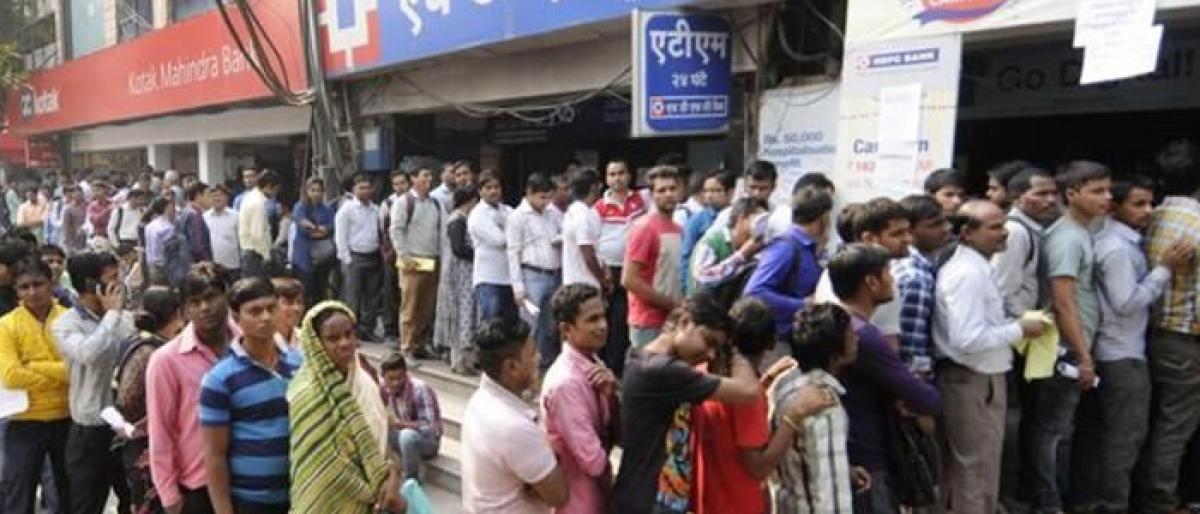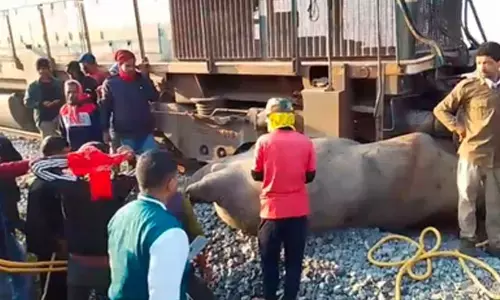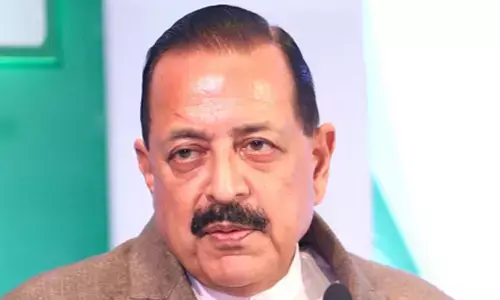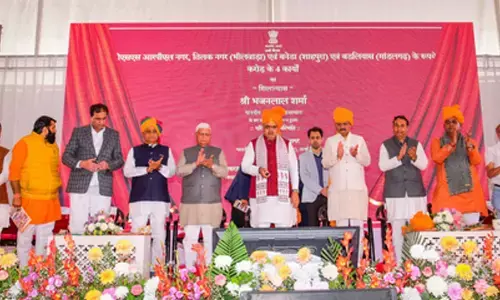A myopic govt that is penny wise…

That Automatic Teller Machines (ATM) in the country had dried up was yesterday’s news. The news today is that that the banks themselves have become cashless.
That Automatic Teller Machines (ATM) in the country had dried up was yesterday’s news. The news today is that that the banks themselves have become cashless.
For some time after the introduction of the demonetisation programme, there was a limit on the amount a person could draw in a week’s duration. At one point of time, we were told that the crisis was over.
Again now, the banks are telling the customers that, no matter what the acuteness of their need, there is simply no cash available. At best, the banks say, that an amount of ₹ 2,000 can be drawn every day from the POS (Point of Sale) machines at business outlets. But then, in these days, how far will ₹ 2,000 take a person?
Somebody asked a bright question, indeed. As customers we are told that the failure to maintain a minimum balance in our bank accounts will entail a penal levy. Then, why cannot such a penalty be levied on banks when they do not permit us to draw a certain minimum amount of cash?
The Chairman of the State Bank of India claims that, of the 2.2 lakh ATMs in the country, 86% are in working order. What he appears not to be revealing is the fact that there is no cash inside those machines! All that a customer can hope to do is to conduct some ‘balance enquiry’ or perform an operation like a ‘pin change.’ By definition, an ATM is duty-bound to deliver cash.
That is its primary responsibility. To date all the ATMs in the country put together have delivered 2 to 2.4 lakh crore rupees to customers. It is after the introduction of demonetisation that these machines lost their value, as most of them were not modified to respond to the requirements of the new situation. For example, out of the 9,000 ATMs in Telangana state, nearly 40% are not being loaded with cash. 20% are being loaded once in a week.
The remaining 40% alone are being loaded to the requisite level. Even the ATM industry association has admitted that, on the whole, in the country, there is a significant drop of 30% in the cash being loaded into the ATMs.
When one questions about the reason for the current situation, the reply given is that it is on account of the imminent elections in Karnataka and the two Telugu states. It is alleged that political leaders are making massive cash withdrawals to hoard money and that the entire fault is theirs. Curiously enough, there is a similar shortage of cash in Rajasthan and Madhya Pradesh states where, also, elections are due shortly. But, then, elections have occurred in the past too, have they not? Why should this inconvenience arise only now and not in the past?
And, in any case, do all parties distribute only cash during directions? After all, it is not unknown that things like arrack, cricket-kits, silver were and pulses etc., are also distributed to attract the voters. And in UP, at the time of elections, cash was freely available. Not only then, but even when the whole country was experiencing acute distress on account of the shortage of currency, it was ensured that UP was spared that problem. And now Maharashtra, Gujarat and Bihar are also experiencing the shortage.
Recently a video went viral, in which currency notes are raining upon a singer. And in Tamil Nadu a deity’s idol was worshipped with a garland of currency notes, a video of which also is doing the rounds.
The situation is as if those who are lucky can access cash and those who are not are denied. Even at the most difficult times in the aftermath of the demonetization, no well-to-do person was seen in any of the queues for currency. Bundles of notes appeared in their houses, as if by magic!
It is said that, in the Telugu-speaking states, the shortage of currency is on account of the activities of political leaders. And in Punjab and Madhya Pradesh states, on account of procurement. The question one would like to ask is whether procurement did not take place in the previous years and, if it did, why this difficulty was not experienced at that time.
It has to be conceded that there appears to be a good deal of force in the argument that the central government and the Reserve Bank of India (RBI) are being far from impartial, as between states, in the matter of distribution of currency. None other than the Union Minister of State for Finance, S P Shukla, has admitted that the situation has been caused by the failure to adhere to the prescribed norms in the distribution of currency. It is indeed unfortunate that RBI is in a situation of being unable to resist pressures from the central government.
On the whole, it has to be conceded that the Government of India has a major responsibility to accept in creating the present situation. With the intention of forcing people to turn towards digitisation it had imposed a 44% cut in the production of small currency by the security press at Nasik. It also froze the printing of ₹2,000 notes. RBI placed restrictions on the movement of currency, from bank branches having excess currency, to those experiencing a shortage.
Simultaneously, there was also a steep reduction in the supply of cash to all banks. For example, only ₹ 629 crores worth of currency was supplied to all the branches of the State Bank of India in Telangana state in the period 2017 September to 2018 January. This was a mere third of the amount supplied every month during the period 2016 November to 2017 August.
The RBI is yet to explain the logic behind this sudden reduction. Having done all this, RBI has recently stated that the fresh study conducted by it has revealed a shortage of 70,000 crores of cash and that, therefore, it will print notes continuously. Somewhat like closing the stable door after the horse has bolted, what!?
What defies logic is that that the same government which declared that the demonetisation of the
₹ 1000 note, purportedly to curb the proliferation of black money, should have brought in the ₹ 2,000 note simultaneously. It is, after all, common knowledge that notes of larger denomination are used for hoarding black money.
Prior to demonetisation, the percentage of notes of the denomination of 50 and 100 was close to 86% of the total notes in circulation. With a view to demonetising those notes, and bringing into circulation freshly printed notes of the same value, the government contented itself with printing notes of Rs 2,000 denomination alone and did not go in for printing those of ₹ 200 denominations.
Soon, most people started hoarding the ₹ 2,000 notes. Those having them are not bringing them out for depositing in banks. Although forewarned about this development, the government is now blaming the political leaders for the travails of the public.
It is, after all, well known that people are prone to holding any commodity which is in short supply, be it cash kerosene or sugar. When there is a commonly shared faith that given commodity will be available in adequate quantities, there is hardly any clamour for it in the public mind. The fear, that cash deposited in banks may not be readily accessible it is felt, is causing a disinclination to deposit money in banks – the fear psychosis government must take the blame for creating.
And it is not as if, despite all this, even the demonetisation is proceeding smoothly or efficiently. On account of the failure to remove the charges levied on digital transactions, the total value of such transactions fell from 2.13 lakh crores, in May 2017, to 1.15 lakh crore in February 2018.
The decision to implement strictly the provisions of the Know Your Customer (KYC) since March this year has also resulted in merchants and other users being reluctant to use ‘wallets.’ And, this has led to an increase in the number of cash transactions.


















